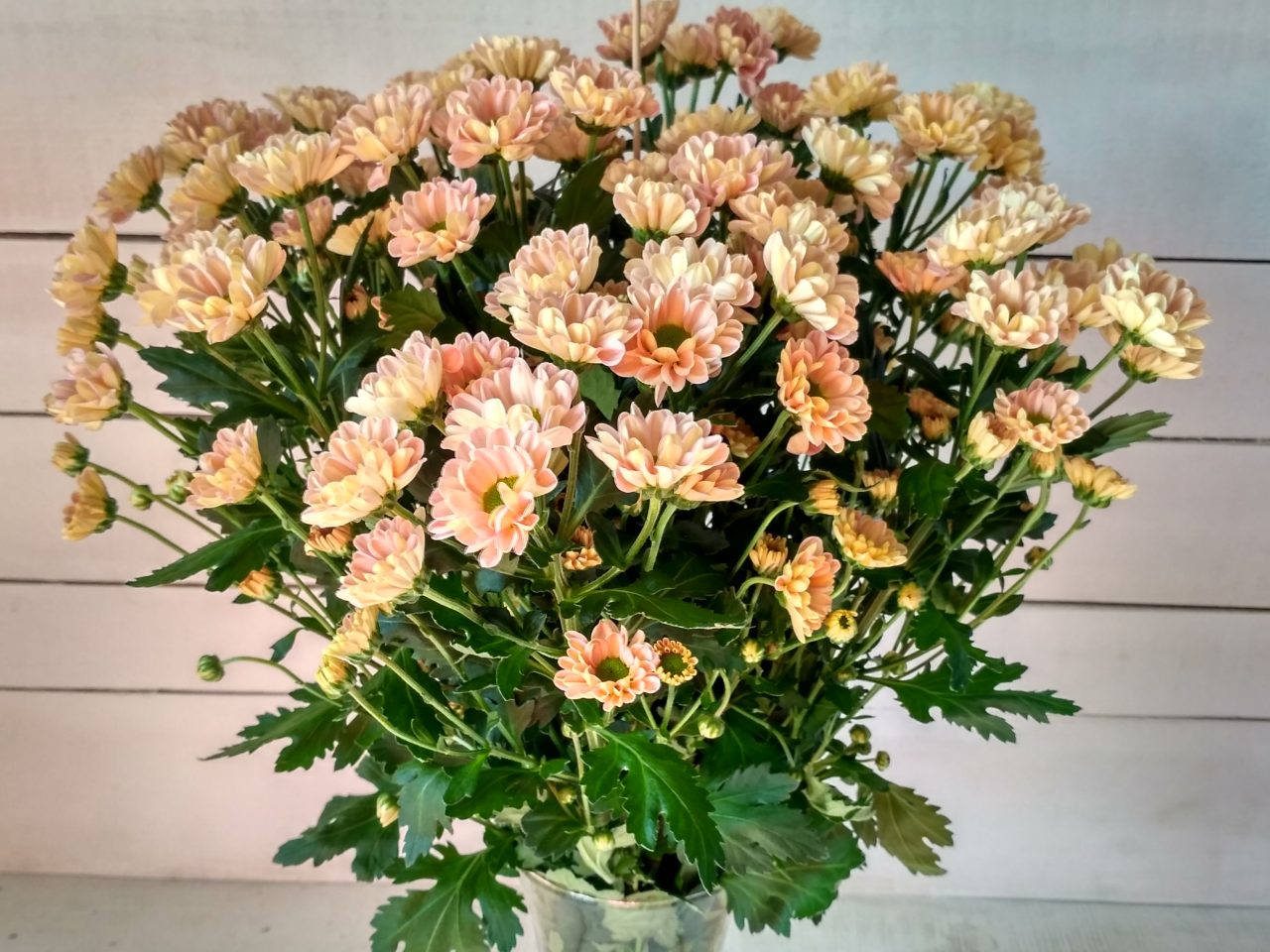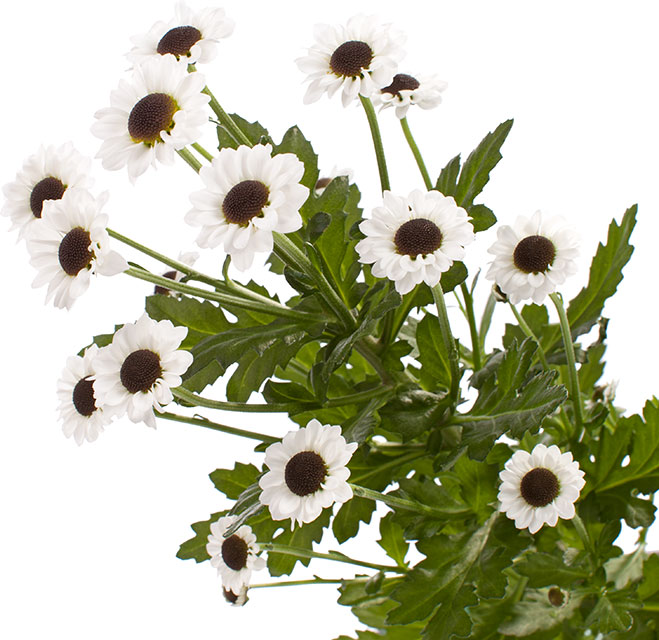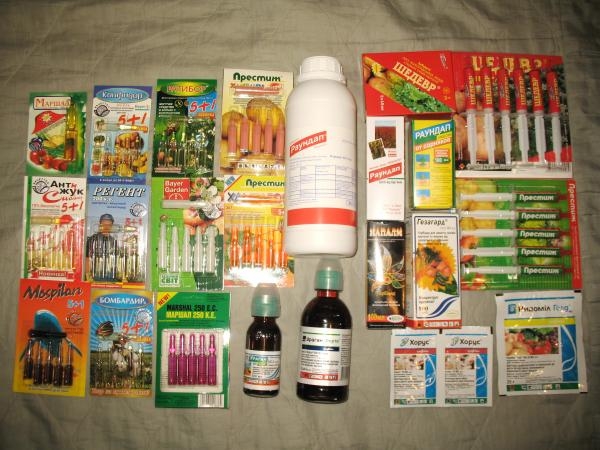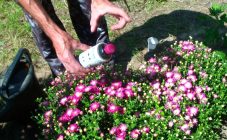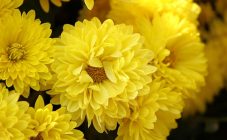Content:
Chrysanthemum santini (simply sa) is a small-flowered bush plant, a separate species. The name comes from the combination of parts of two words - the international Chrysanthemum and the Latin word mini, that is, miniature. Thus, santini is a miniature chrysanthemum. In height, it rarely reaches 40-50 cm and belongs to low and medium-sized plants, depending on the selected variety.
This flower was first bred in Holland, and initially there were only varieties with white inflorescences, but now other colors are also widespread: green, orange, bright yellow, red.
Chrysanthemum bush santini is very popular among florists, because of the variety of options for its appearance, as well as the beautiful shape of the inflorescences. It is convenient to use it for making bouquets, since a small-sized flower can favorably set off the rest of the composition, and a mix of different varieties looks very cute and not pretentious. One bush usually grows 25-30 inflorescences. Their shape may vary depending on the variety. So, there are chamomile, pompom, terry inflorescences.
In general, if you look through the catalog with varieties, it will become clear that there is little in common in the appearance of flowers.
Description of the species
All varieties of this type of chrysanthemum can be divided according to two criteria - the height of the bush and the diameter of the inflorescence. The average height is 40 cm, and the diameter of one inflorescence does not exceed 4 cm. On average, the weight of one bush is slightly less than a kilogram and is equal to about 700-800 g. Due to their small size, they are often grown not in open ground or in a greenhouse, but in pots.
Different varieties are similar in root system - usually the roots of the plant are located close to the surface, they are small in size and of average thickness. Thanks to this, the flower is convenient to grow in pots or flowerpots.
The beginning of the flowering period also depends on the specific variety, since there are both early-maturing and late-flowering specimens among santini. Depending on the variety, the shape of the petals also changes, for example, they can be chamomile or astrovid, rounded or elongated and pointed.
Popular varieties
Since it is rather difficult to list all the existing varieties of santini, the article will only mention those that are most often grown by experienced florists.
- Bounser (Bunser)... There are several color variations - green, yellow, red and creamy. The stems of the chrysanthemum santini Bouncer are quite thin, and the diameter of the inflorescences rarely exceeds 4 cm. The core of the flower is of different shades of green, which contrasts sharply with its color. Chrysanthemum sa Bunser is the most common variety among summer residents of the Moscow region.
- Country. Santini (sa) CountryAre chrysanthemums of pure green and yellow-green colors. Usually they have a pompon or spherical shape of inflorescences, a small diameter and sharp petals, with which the core merges in color.
- Yin Yang... It is an elongated flower with chamomile inflorescences. The chrysanthemum got its name from its flowers with white petals and black hearts. Chrysanthemum Yin-Yang exists in a single color variety.
- Chrissy. Reminiscent of Yin-Yang - medium-sized inflorescences, reminiscent of repainted chamomile flowers. The flower has carved leaves and rather tall stems. The color is light pink, the middle is green.
- Advice... The bright yellow flowers with a green core are shaped like chamomile inflorescences, the stem is rather long. The petals are rounded.
- Calimera... It differs not only in smaller flowers, but also in color. The color of the petals changes, becoming lighter from the center to the beginning. The color of flowers can be different: white-green, cream, lilac. However, in colors of bright shades - red, bright yellow - this effect is not so noticeable.
- Madiba. The main difference of the variety is the inflorescences, the diameter of which is 2 cm. There are white, pink, yellow and red Madiba chrysanthemums.
Features of planting and care
Like many other varieties of santini, it does not require a lot of tricks in the care. It is unpretentious enough to grow in almost any conditions. However, since this is a hybrid species, it will not work to grow it from a seed.
Santini is a fairly frost-resistant species, but it is important to remember that this indicator is rather arbitrary. Therefore, when growing it in the Middle Lane, it is imperative to take measures to protect it from cold weather.
In general, the recommendations for growing santini outdoors will be similar to the rules that apply to planting any chrysanthemum bush. The main ones are:
- planting begins in mid - late April, if we are talking about a harvested greenhouse, or in May in open ground, after the main frosts have passed;
- optimal soil - loose and fertile, without stagnation of moisture;
- immediately before planting a flower, the soil is loosened;
- the recommended height of the pit for planting is about 40 cm;
- before planting, organic fertilizers are added to the soil;
- if there is too much moisture in the soil, they usually use a drainage system, on top of which an earth layer is poured, and only then the roots of the plant are laid;
- bush chrysanthemum requires regular and abundant watering;
- for the winter, the plant is either covered or transplanted into pots and transferred to a room in order to return it back to the flower bed in the spring. Since the santini is small in size, flowers can be dug in with the pots without replanting them.
Major diseases and pests and control measures
Since these plants have high immunity, it is customary to regularly spray them as a preventive measure with drugs against infections and various pests, as well as protozoan parasites. Do this 2-3 times per season.
Here are the 3 main problems that most growers face:
- pests;
- infectious and parasitic diseases;
- rotting roots.
One of the most common santini ailments is fungal infections such as powdery mildew. The reasons for its occurrence can be different:
- insufficient ventilation of rhizomes;
- an increased level of soil acidity;
- a large percentage of nitrogen in the soil.
Fungicides are used to treat the fungus.
The main methods of pest control include:
- preventive treatment of the plant with special preparations - insecticides;
- removal of damaged parts of the plant;
- changing the top of the soil or replanting a flower.
In general, there is nothing difficult in caring for a santini, if you carefully monitor the condition of the flowers, and react in time to problems with their health.
